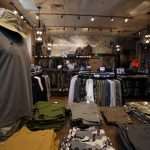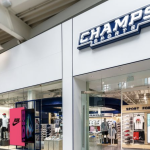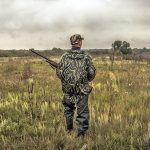While the company’s success in the hunting space rarely comes up during investor presentations, a cursory look at the UA earnings reports show that the training and hunting categories have been the top two drivers of unit growth at the company in since 2012.
But UA is merely the most visible of a half dozen brands that have grown rapidly in the last decade by bringing modern performance fabrics and materials developed by athletic and mountain sports brands to the hunting market.
Only 10 years ago, the suggestion that hunters would pay a premium price point for synthetic base layers that wicked moisture and waterproof-breathable outerwear was dismissed as asinine by many in the hook and bullet channel, expressed Jonathan Hart, who co-founded Sitka Gear with fellow University of California at Davis alumni and backcountry enthusiast Jason Hairston in 2005.
“Looking at clothing as gear and a system was a concept that did not exist,” Hart told Sports Executive Weekly in August. “Only the people who crossed over into the mountain sports side understood what a ‘wicking layer’ meant. Then when people tried to take a stab at it, they still did not get it. They thought it was
just a more athletic cut with synthetic apparel, but we are talking about DWR, stretch mechanics, heat maps, moisture management.”
Hart and Hairston saw a big opportunity for anyone who could persuade hunters who owned $1,000 bows, $50,000 pick-up trucks, or $30,000 duck leases to spend $1,000 on a layering system to make sure they enjoyed maximum comfort and performance during their hunts. Their thesis was validated in 2006 when Schnee’s the only retailer to pick up Sitka in its inaugural season – sold through its entire stock in 90 days. By 2007, Sitka was carried by every major big-box hunting retailer in the U.S.
In 2009, Sitka partnering with W.L. Gore & Co. to develop Optifade, the first concealment technology based on scientific research on how deer and other ungulates actually see. The next year, as the economy tanked, W.L. Gore acquired Sitka Gear as a best-in-class vehicle for launching Optifade, Gore-Tex and other technologies into an industry dominated by look-alike camouflage brands. The sale caused a bitter split between Hart and Hairston. Hairston went on to found Kuiu, a Dixon, CA, brand that uses fabrics from the Japanese textile firm Toray and sells direct-to-consumer.
Soaring Market Share
Long story short, no one is dismissing Sitka Gear now. By 2012, UA was plowing more money into its hunting products, Cabela’s had launched its Alaskan Guide Series of hunting apparel featuring Gore-Tex and other technologies, and the performance language used by Sitka Gear was surfacing in ads across the industry.
Through August, Sitka Gear was the third best-selling hunting apparel brand after UA and private label brands, according to SSI Data, which collects and analyzes point-of-sale (POS) data from more than 15,000 retail doors nationwide. The data show Sitka Gear’s market share more than doubled compared with the first eight months of 2014 with much of the gains coming from private label.
UA, meanwhile, beat out a host of firearms and other incumbent hunt apparel brands to land at the top of the Sportsman’s Brand Strength Index published by SportsOneSource research group earlier this year.
Slumberjack Awakens
The success of these pioneering brands has spawned start-ups, including Prois, a Gunnison, CO-based maker of technical hunting apparel for women, and provided endemic brands a new growth path.
Slumberjack refocused on its hunting roots in 2014 in a bid to reinvigorate its brand while staying authentic to its heritage, which included a close association with hunting from the 1960s through the 1980s, according to Marketing Manager Marilyn MacDonald. Research also revealed that there was an opportunity to produce hunting packs using the coveted Kryptek camo patterns at a price and feature set that would work for Sportsman's Warehouse and other big box specialty retailers.
In January 2014, Slumberjack launched a line of hunting-specific backpacks and cloaks garments meant to keep hunters warm during hours of waiting in tree stands – and accessories at the SHOT Show that hit retail that summer. Among the products was the Slumberjack Rail Hauler, a $300 frame pack system featuring a Kryptek camo roll-top pack that can be used with an aluminum frame to carry loads of up to 200 pounds using the same shelf system design offered by much more expensive brands.
“They are like the Burberry or Louis Vuitton of camo for that tribe,” said MacDonald. “We are the only brand importing packs with that pattern. So, if you want a pack in this camo, you have to get it from us. Some U.S. brands are buying fabric and sewing in the U.S., but those cost $800.”
Slumberjack has opened 130 new doors since its rebranding. It is back into Bass Pro after a six-year absence and testimonials from hunters have helped drive up its following more than sevenfold to nearly 50,000 on Facebook.
This fall, Slumberjack dealers began selling an Arctic version of its cloak that is twice as warm for hunters in the Midwest; a new camo version for other states that require hunters to wear safety orange; and packs using the greener Mandrake Kryptek pattern, which is more suitable for non-deciduous regions. At Outdoor Retailer in August, the brand debuted its redesigned tents, sleeping bags, and camp chairs, which will hit retail next spring. In fall 2016, it will roll out women-specific packs.
“We are swimming upstream,” MacDonald said of the brand’s efforts to penetrate big hook-and-bullet retailers. “But when we put products up against
the competition, it's still really affordable and the sales provide validity and a future for SJK's new initiatives.”
A Wholesale Change At Mystery Ranch
Mystery Ranch, a direct-to-consumer brand that has built its brand by designing and sewing packs for awkward loads carried by solders, fire fighters, and hunters, is setting up an offshore supply chain for the first time in its 15-year history, in a bid to launch a wholesale business.
While the Bozeman, MT-based company will continue to make all packs for the U.S. military, and a large percentage of its packs for firefighting in the U.S., it is shifting manufacturing of its consumer packs to the Philippines to dial in wholesale pricing.
“The wholesale strategy will allow us to work with retailers with a margin and lower the MSRP to the end consumer online or in-store by 5-to-10 percent, while maintaining the same durability you’ve come to expect from Mystery Ranch,” said Ryan Holm, marketing manager for Mystery Ranch.
Mystery Ranch has marketed its Metcalf Pack as the “minimalist hunter's go-to pack” for several seasons, because of it’s durable, no-fail load carriage design for longer pack outs. Features include an “overload shelf,” which can be inserted between the frame and the main pack to haul meat; 10 compression straps to tighten awkward loads, rifles, and compound bows; and a full-side zip for easy access.
At Outdoor Retailer this past August, Mystery Ranch debuted its new line of packs that will be manufactured in the Philippines.
“It’s becoming more popular among backcountry hunters to go further and longer,” said Holm. “A lot of outdoor industry people have pushed the envelop so far forward that hunting brands are just getting up to speed.”
The Yeti Effect
At Sitka Gear, Hart said the performance apparel trend still has a lot of runway in the hunting space. He estimated that only about 20 percent of Western big game hunters and 5-to-10 percent of white tail and waterfowl hunters have migrated to performance gear.
Some retailers sense an even larger opportunity similar to the one Yeti Coolers harvested. Just as some Mystery Ranch packs are designed for the rigors of
hauling meat from the backcountry to the trailhead, Yeti products were designed by two Texas sports fishermen looking for a way to keep their catch fresh on deep sea fishing trips. The pricey coolers’ ability to keep food and beverages cold for days made them as big a hit in suburbia as the wilderness.
“One of the things we hope is happening is that Sitka is changing the perceived value of a hunting jacket just the way Yeti has become the cooler to own,” said Scott Wood, a buyer for Great Outdoor Provision Co., which began carrying Sitka in 2013. “We are selling Yeti coolers to people who will put a quarter of a deer or a Spanish mackerel in them, but we are also selling to a lot of moms.”
Until then, Sitka will continue building out its product line.
“Our big announcements at SHOT Show will be around waterfowl,” said Hart, referring to the shooting sports industry’s annual trade show in January. “With all the ups and downs of the economy, we have not seen a single blip. Our insulation to the economy is almost scary.”













